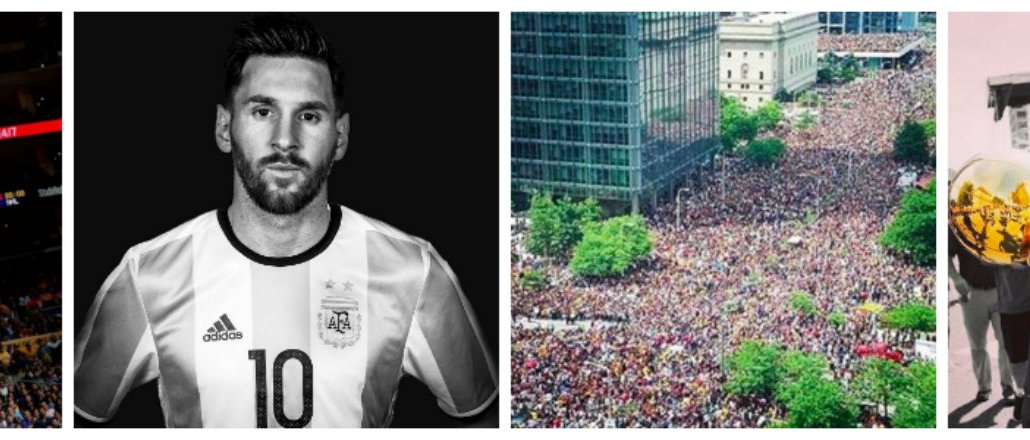
Next to LeBron James and the Cleveland Cavaliers, the biggest winner of the 2016 NBA Finals was arguably ABC, which averaged 20 million viewers for the seven-game series. However, based 25 miles away from Oakland’s Oracle Arena, Instagram executive Brandon Gayle felt some of the Cavaliers’ euphoria. After all, during the course of the NBA Finals, 26 million people interacted 186 million times with series-related content on the platform.
Gayle, who joined Instagram from parent company Facebook in January, has an important role at the photo- and video-sharing social network. As Instagram’s global head of sports partnerships, his job is to get more people from the world of sports — athletes, teams, leagues and media companies — to use the platform.
He’s got a head start: Sports is huge on Instagram. Of the 500 million people that use Instagram every month, 165 million are sports fans — meaning they follow at least one sports-related account, the company said. On average, sports fans on Instagram follow eight sports accounts.
“We identified sports as a major passion point and interest on the platform. My role was created to go after that by thinking about the different parts of the ecosystem and how we can serve them,” said Gayle.
Instagram’s popularity within the sports community is certainly driven by personalities. Of the eight accounts the average sports fan on Instagram follows, six are athlete accounts, the company said. Soccer star Cristiano Ronaldo has the most-followed sports account on Instagram with 68.1 million followers. Stateside, the NBA alone has 30 active players with at least 1 million followers on the platform.
“What’s happening more and more, athletes are enjoying sharing their authentic selves and engaging with their fans on social platforms,” said Mike Mikho, CMO of Laundry Service & Cycle. “When that translates to a visual piece of content, Instagram is the outlet for them.”
Sports as a category overall is growing on Instagram. For instance, 30 million people generated 185 million interactions (posts, likes and comments) during the 2015 Copa America competition. That number grew to 40 million people and 231 million interactions for the recently completed 2016 tournament.
With this growth, Instagram is putting resources toward getting more sports personalities, teams and leagues to use the platform. This includes growing a team that can serve the different constituencies within the world of sports. Today, Gayle’s team is organized around the big pieces of the sports ecosystem. For instance, one team member is responsible for soccer — the top sport on Instagram with 100 million followers — on a global level. Another staffer looks after creative programs, such as a recent partnership between Instagram, the NBA and GQ to create visual portraits for top-10 NBA Draft picks.
Instagram’s sports team takes a consultative approach, offering tips and tricks to athletes, teams, leagues and media partners on what works best for the platform. When Rob Gronkowski decided to join Instagram, the team worked with the Patriots star to create a 60-second video detailing his off-season activities. This happened around the time Instagram expanded its video limit to 60 seconds and allowed users to insert multiple clips into a single video.
“We’re actively looking to find those opportunities and on-board athletes who aren’t on the platform and support them creatively,” said Gayle.
With different teams and leagues, the Instagram team often goes on-site to set up different content opportunities. For instance, at the NBA All-Star Weekend, Instagram and the NBA created an installation that allowed players to hop in and create looping videos using Instagram’s Boomerang app. That helped the NBA generate more than 65 million views across the four-day weekend.
Other social platforms including Snapchat and Twitter have been looking to take advantage of this popularity. Twitter will live stream eight NFL games during the coming season and has partnerships with multiple leagues to distribute clips and sell ads against that content. Snapchat often produces live stories around big sporting events, counts ESPN as a Snapchat Discover publisher and will soon launch Discover channels for the Olympics and the NFL.
Each of these platforms offers value, according to marketers. “Instagram currently has more robust targeting capabilities, and the channel thrives from high-quality photos, typically taken from a unique perspective,” said Jessica Prassel, associate director of search and social at Mindshare North America. “It’s a great outlet for sports marketing to showcase new products, give teasers or sneak peeks and share behind-the-scenes photos and videos.”
The most popular sports on Instagram today are soccer and NBA basketball, followed by combat sports and action sports. Part of Gayle’s responsibility going forward is to shepherd other sports leagues and teams onto the platform.
“You can rest assured folks at the NFL, NHL and MLB are watching what the NBA is doing and thinking about what their strategy should be,” he said. “We are talking to them as well.”
More in Media

Podcast companies turn to live events to capture growing advertiser spend
The surge in the number of live podcast events in 2025 reflects a broader shift: advertisers are betting bigger on podcasts — not just as an audio channel but as a full-fledged creator economy play.

Media Briefing: ‘Cloudflare is locking the door’: Publishers celebrate victory against AI bot crawlers
After years of miserably watching their content get ransacked for free by millions of unidentified AI bot crawlers, publishers were finally thrown a viable lifeline.

How Vogue could navigate potential industry headwinds as Anna Wintour — who agency execs say made ad dollars flow — brings on new edit lead
Anna Wintour’s successor at Vogue will have to overcome the myriad of challenges facing fashion media and the digital publishing ecosystem.





